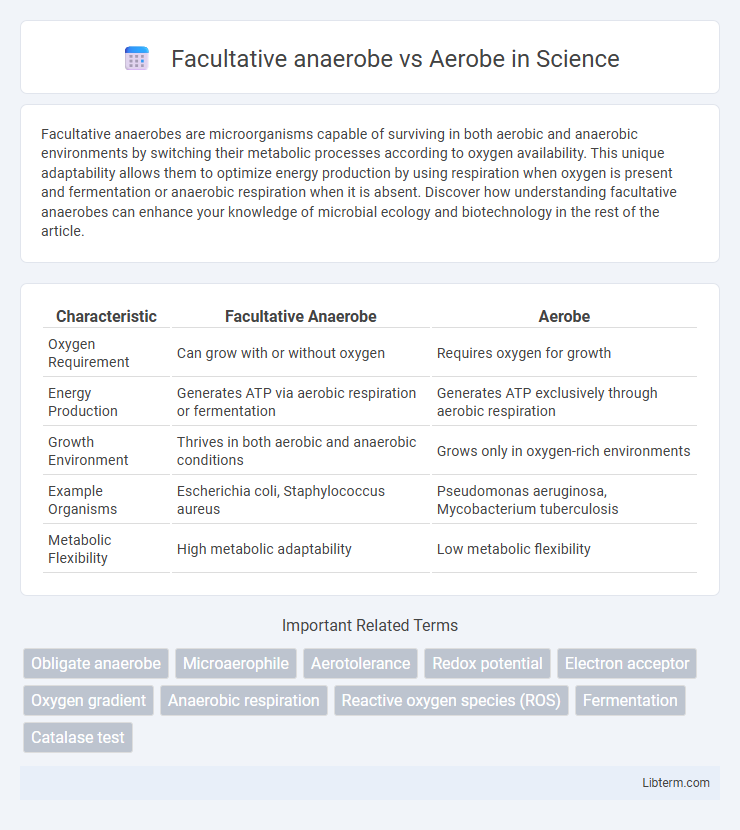Facultative anaerobes are microorganisms capable of surviving in both aerobic and anaerobic environments by switching their metabolic processes according to oxygen availability. This unique adaptability allows them to optimize energy production by using respiration when oxygen is present and fermentation or anaerobic respiration when it is absent. Discover how understanding facultative anaerobes can enhance your knowledge of microbial ecology and biotechnology in the rest of the article.
Table of Comparison
| Characteristic | Facultative Anaerobe | Aerobe |
|---|---|---|
| Oxygen Requirement | Can grow with or without oxygen | Requires oxygen for growth |
| Energy Production | Generates ATP via aerobic respiration or fermentation | Generates ATP exclusively through aerobic respiration |
| Growth Environment | Thrives in both aerobic and anaerobic conditions | Grows only in oxygen-rich environments |
| Example Organisms | Escherichia coli, Staphylococcus aureus | Pseudomonas aeruginosa, Mycobacterium tuberculosis |
| Metabolic Flexibility | High metabolic adaptability | Low metabolic flexibility |
Introduction to Oxygen Requirements in Microorganisms
Facultative anaerobes can grow in both the presence and absence of oxygen, using aerobic respiration when oxygen is available and switching to anaerobic metabolism or fermentation without it. Aerobes strictly require oxygen for growth and energy production through aerobic respiration. Understanding these oxygen requirements in microorganisms is essential for optimizing microbial cultivation and studying their metabolic pathways.
Defining Facultative Anaerobes
Facultative anaerobes are microorganisms capable of surviving in both the presence and absence of oxygen by switching between aerobic respiration and anaerobic metabolism. Unlike obligate aerobes, which require oxygen for growth, facultative anaerobes optimize energy production through aerobic respiration but can utilize fermentation or anaerobic respiration when oxygen is scarce. This metabolic versatility allows facultative anaerobes to inhabit diverse environments, including oxygen-rich tissues and oxygen-depleted niches.
Defining Aerobes
Aerobes are microorganisms that require oxygen for growth and energy production through aerobic respiration. They use oxygen as the terminal electron acceptor in their metabolic processes, enabling efficient ATP generation. Facultative anaerobes can switch between aerobic respiration and anaerobic methods, but aerobes strictly depend on oxygen for survival and metabolic activity.
Key Differences Between Facultative Anaerobes and Aerobes
Facultative anaerobes can survive in both the presence and absence of oxygen by switching between aerobic respiration and fermentation or anaerobic respiration, while aerobes require oxygen for survival and rely exclusively on aerobic respiration. Facultative anaerobes possess metabolic flexibility that allows energy production in varying oxygen levels, whereas aerobes depend on oxygen as the final electron acceptor in their electron transport chain. Key differences also include habitat adaptability and enzyme systems, with facultative anaerobes containing enzymes like superoxide dismutase and catalase to neutralize reactive oxygen species in aerobic conditions.
Metabolic Pathways: Aerobic vs Facultative Respiration
Facultative anaerobes utilize both aerobic respiration and fermentation or anaerobic respiration depending on oxygen availability, enabling metabolic flexibility by switching pathways to optimize energy production. Aerobes rely exclusively on aerobic respiration, using oxygen as the terminal electron acceptor in the electron transport chain, resulting in efficient ATP generation via oxidative phosphorylation. The metabolic versatility of facultative anaerobes involves enzymes such as cytochrome oxidase under aerobic conditions and alternative reductases during anaerobic respiration, highlighting distinct biochemical adaptations to oxygen presence.
Ecological Niches and Environmental Adaptability
Facultative anaerobes thrive in diverse ecological niches due to their ability to switch between aerobic respiration and anaerobic metabolism, allowing survival in fluctuating oxygen levels from soil to aquatic environments. Aerobes occupy strictly oxygen-rich habitats such as surface waters, soil layers, and host-associated environments, relying exclusively on oxygen for energy production. This metabolic flexibility enables facultative anaerobes to dominate transitional zones where oxygen availability varies, enhancing environmental adaptability compared to specialized aerobes.
Energy Production Efficiency
Facultative anaerobes produce energy through aerobic respiration when oxygen is available, yielding up to 36-38 ATP molecules per glucose molecule, while switching to less efficient anaerobic fermentation under anaerobic conditions, producing only 2 ATP per glucose. Aerobes rely exclusively on oxidative phosphorylation, maximizing energy extraction with high ATP output from glucose metabolism. The flexibility of facultative anaerobes allows adaptation to fluctuating oxygen environments, but their energy production efficiency is lower during anaerobic fermentation compared to strict aerobes.
Examples of Facultative Anaerobes and Aerobes
Escherichia coli and Staphylococcus aureus are prime examples of facultative anaerobes, capable of surviving in both oxygen-rich and oxygen-poor environments by switching between aerobic respiration and fermentation. In contrast, Pseudomonas aeruginosa and Mycobacterium tuberculosis exemplify aerobes that require oxygen for growth and rely solely on aerobic respiration. These distinctions highlight the metabolic versatility of facultative anaerobes compared to the obligate oxygen dependence of aerobes.
Importance in Medical and Industrial Contexts
Facultative anaerobes, able to survive with or without oxygen, are crucial in medical research for developing treatments against pathogens like Escherichia coli and Staphylococcus aureus. Aerobes, requiring oxygen for growth, play a vital role in industrial fermentation processes and in decomposing organic waste in aerobic bioreactors. Understanding the metabolic flexibility of facultative anaerobes and the oxygen dependency of aerobes enhances the effectiveness of antibiotic strategies and optimizes bioengineering applications.
Summary: Choosing Survival Strategies
Facultative anaerobes adapt to both oxygen-rich and oxygen-poor environments by switching metabolic pathways, using aerobic respiration when oxygen is available and fermentation or anaerobic respiration when it is not. Aerobes rely exclusively on oxygen for survival, using aerobic respiration to efficiently produce energy. Selecting between these survival strategies hinges on environmental oxygen levels and the organism's metabolic flexibility.
Facultative anaerobe Infographic

 libterm.com
libterm.com